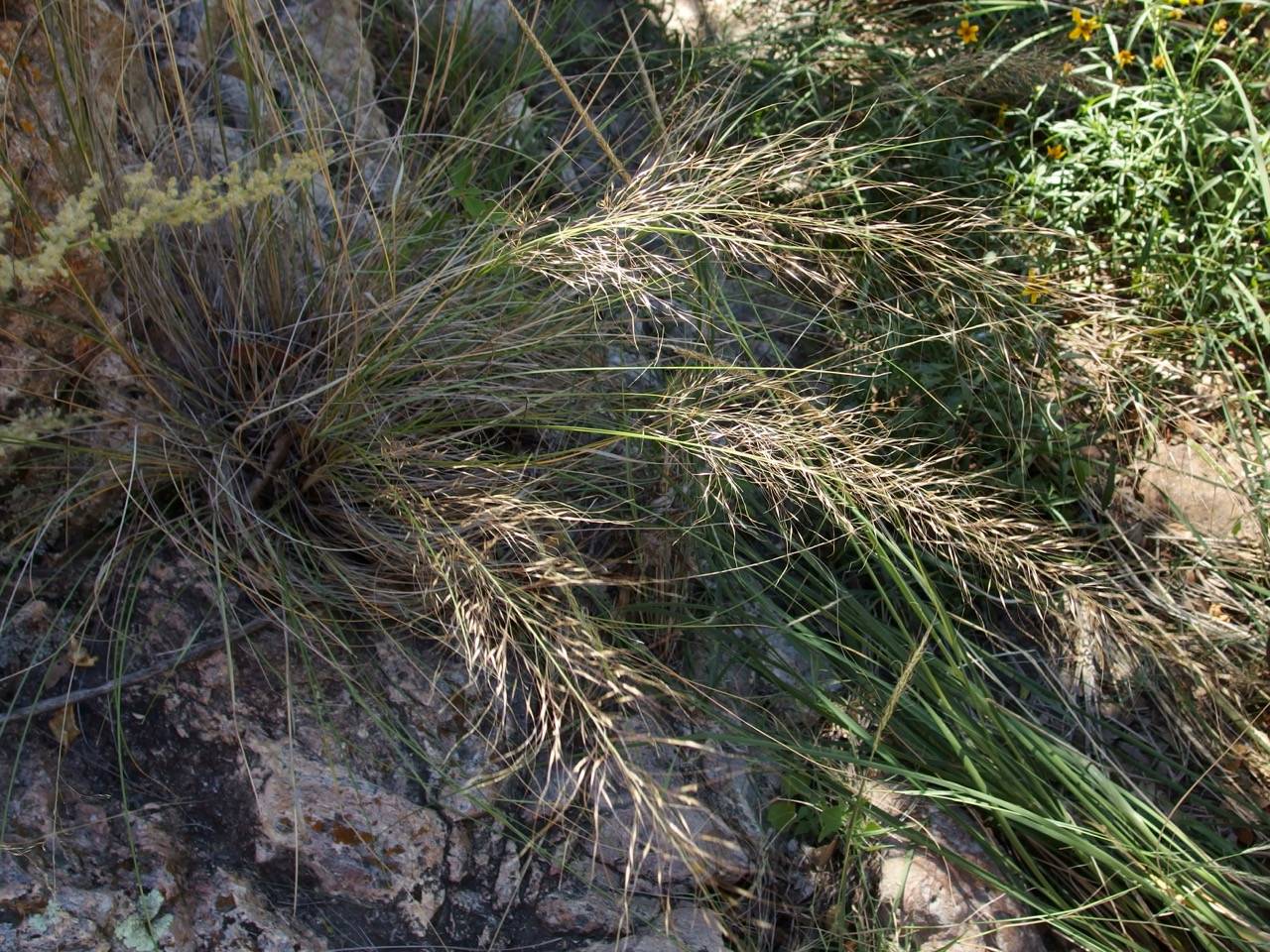Muhlenbergia elongata
|
|
|
|
Family: Poaceae
Arid Muhly, more...sycamore muhly
[Muhlenbergia xerophila C.O. Goodding] |
Plants perennial; cespitose, not rhizomatous. Culms 40-120 cm, erect, not conspicuously branched; internodes mostly smooth, sometimes scabridulous below the nodes. Sheaths longer than the internodes, smooth or scabridulous, rounded towards the base, not becoming spirally coiled when old; ligules 2-8 mm, firm below, membranous distally, obtuse to acute; blades 15-50 cm long, 0.3-1.5 mm wide, flat to involute, smooth or scabridulous abaxially, hirtellous adaxially. Panicles 15-50 cm long, 1-7 cm wide, loosely contracted, not dense; primary branches 1-8 cm, appressed or diverging up to 30° from the rachises, naked basally; pedicels 1.3-8 mm, hispidulous. Spikelets 3-4.2 mm. Glumes subequal, 2-3 mm, exceeded by the florets, glabrous below, minutely pubescent or scabridulous distally, 1-veined, acuminate to acute, unawned or awned, awns to 1.6 mm; lemmas 2.8-4.2 mm, narrow, lanceolate, calluses hairy, hairs to 1 mm, lemma bodies glabrous and smooth below, scabridulous distally, apices acuminate, awned, awns 8-40 mm, straight to flexuous, demarcation of the awns from the lemma bodies not evident; paleas 2.8-4.2 mm, narrowly lanceolate, glabrous, acuminate; anthers 1.4-2.2 mm, yellow. Caryopses 2-2.2 mm, fusiform, brownish. 2n = unknown. Muhlenbergia elongata grows on rock outcrops, cliffs, canyon walls, and moist rock walls, on rhyolitic and volcanic conglomerates, at elevations of 850-2100 m. It extends south from Arizona into northern Mexico. FNA 2003, Gould 1980 Common Name: sycamore muhly Duration: Perennial Nativity: Native Lifeform: Graminoid General: Tufted perennial with stems 40-120 cm, erect, not really branched, with mostly smooth internodes, sometimes minutely roughened below the nodes, sheaths longer than internodes, rounded towards base, not becoming spirally coiled when old. Vegetative: Blades 15-50 cm long, 0.5-1.5 mm wide, flat to involute, smooth to minutely roughened below, hirtellous above, ligules 2-8 mm, firm below broadly rounded. Inflorescence: Panicle 15-50 cm long, 1-7 cm wide, loosely contracted, light brown to pink tinged, primary branches 1-8 cm, appressed or diverging to 30 degrees from the rachises, naked basally, pedicels 1.5-8 mm, hispidulous, spikelets 3-4.5 mm, glumes subequal, 2-3 mm, exceeded by the florets, glabrous below, minutely pubescent or minutely roughened above, acuminate to acute, unawned or awned, awns to 1.5 mm, lemmas 2.5-4.5 mm, narrow, lanceolate, hairs to 1 mm, lemmas bodies glabrous and smooth below, minutely roughened above, awned with awns 8-40 mm, straight to flexuous. Ecology: Found on rock outcrops, cliffs, on canyon walls and moist rock walls, often on rhyolitic or volcanic conglomerates from 4,000-6,000 ft (1219-1829 m); flowers August-November. Notes: Rare species that is known from the type in Sycamore Canyon in Santa Cruz county. Similar in appearance to M. rigida, but without the tight spike inflorescence. Ethnobotany: Unknown Etymology: Muhlenbergia is named for Gotthilf Heinrich Ernst Muhlenberg (1753-1815) a clergyman and botanist from Pennsylvania; elongata means elongated or lengthened. Synonyms: Muhlenbergia xerophila Editor: SBuckley, 2010 |
|
|
|

